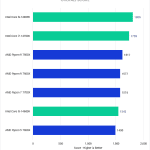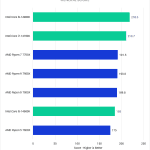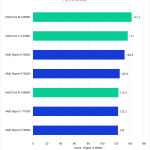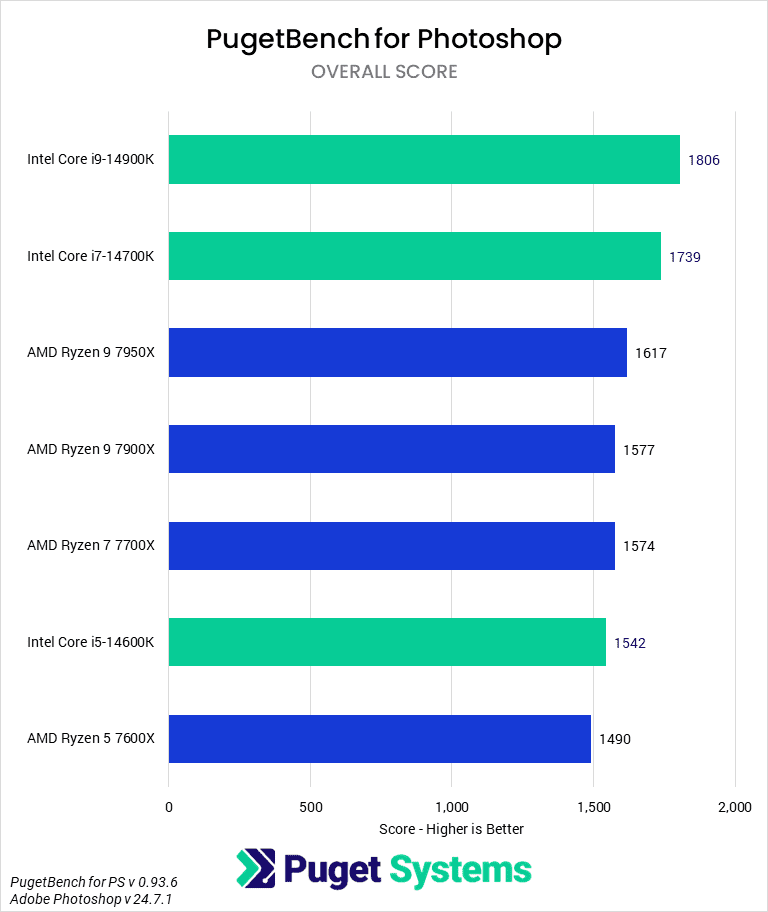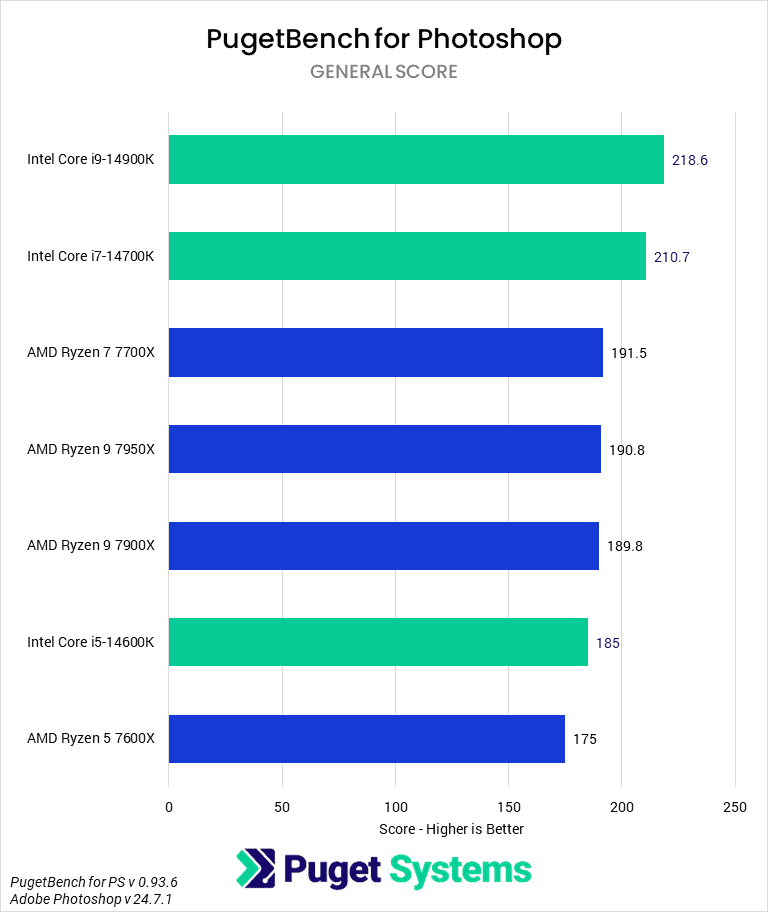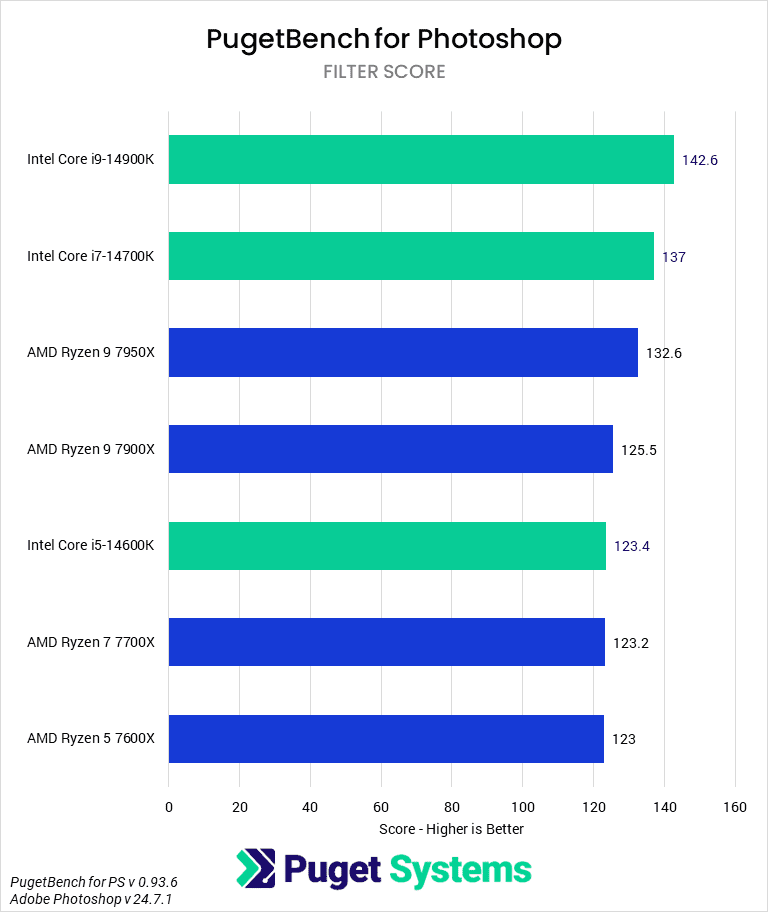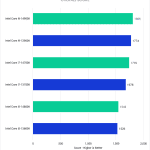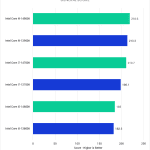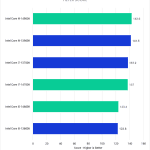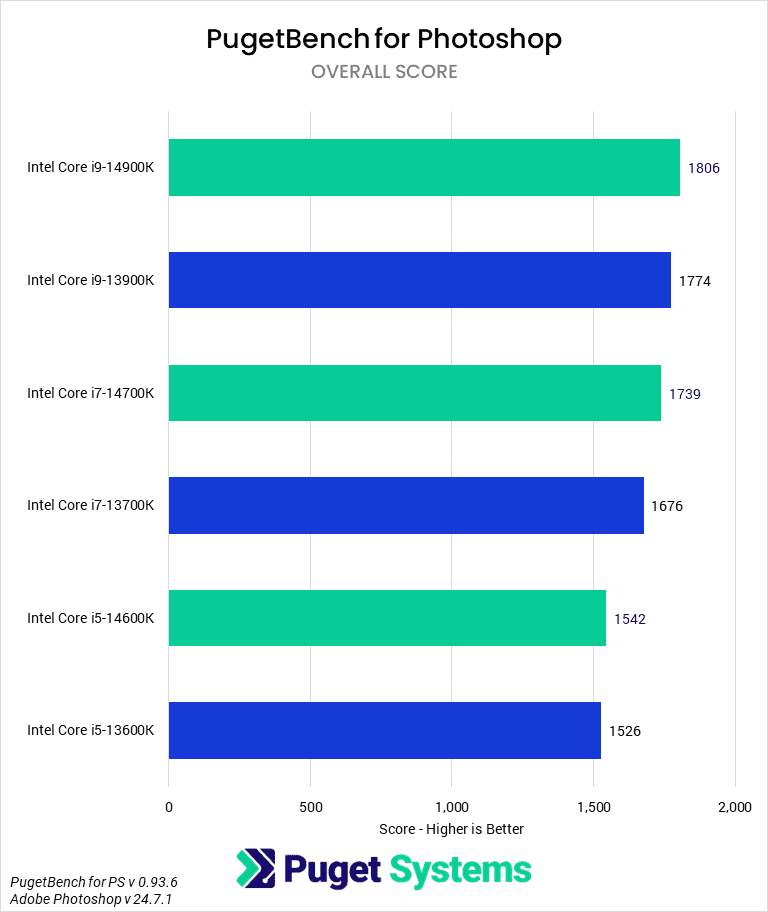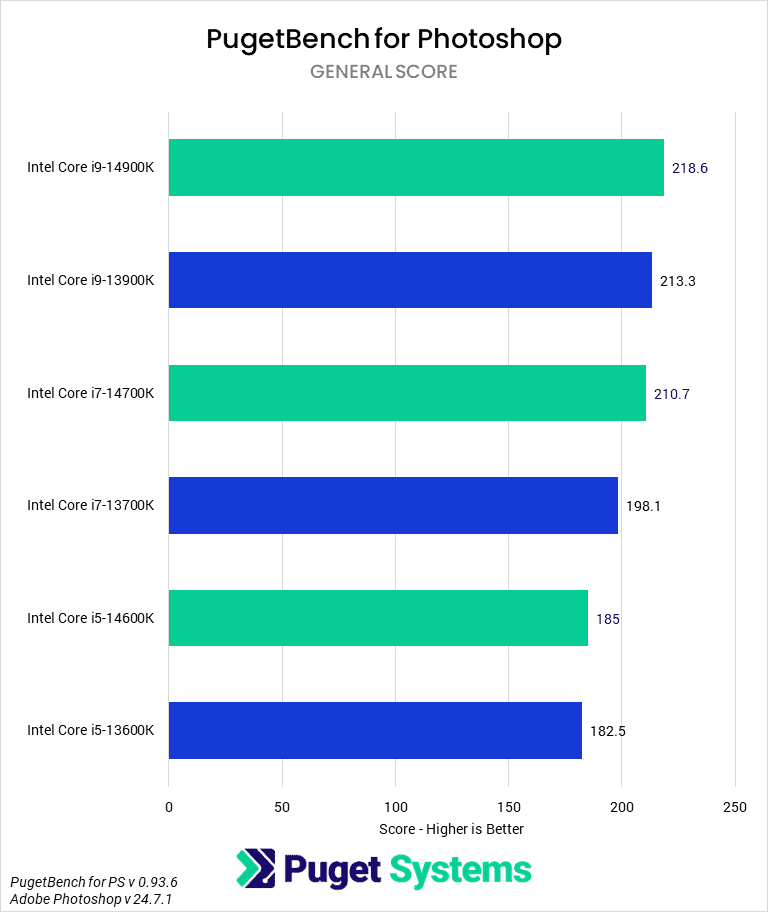Table of Contents
TL;DR: Intel Core 14th Gen performance in Photoshop
The new Intel Core 14th Gen processors work fine in Photoshop, although they perform within the margin of error as the previous 13th Gen processors. Because of this, Intel maintains (but does not extend) their ~10% performance lead over the AMD Ryzen 7000-series processors. This means that the new 14th Gen CPUs are a solid “skip” generation for Photoshop users, and if anything, make 13th Gen more attractive as there may be price drops now that 14th Gen is fully launched.
Introduction
Intel’s new Core 14th Gen processors that are launching today are a fairly minor refresh to their consumer “Core” family of processors. Like the previous two Intel Core generations, these CPUs use a hybrid architecture with a mix of “P” (Performance) and “E” (Efficient) cores and are socket-compatible with both 12th and 13th gen motherboards. These new processors are largely a fairly standard frequency bump of the 13th gen models, although the i7 variant (Core i7-14700K) features four additional “E”-cores over the 13700K which should help in heavily threaded workloads.
In this article, we will examine how these new processors perform specifically in Adobe Photoshop. Intel has traditionally held the lead in this type of application due to their higher single-core performance, so the main question is if there is enough of a gen-over-gen performance gain over the previous 13th Gen that they will further extend their lead over AMD Ryzen. Because there are so many CPUs to examine, we will break our analysis down into Intel vs AMD (Intel Core 14th Gen vs AMD Ryzen 7000) and performance versus the previous generation (Intel Core 14th Gen vs Intel Core 13th Gen).
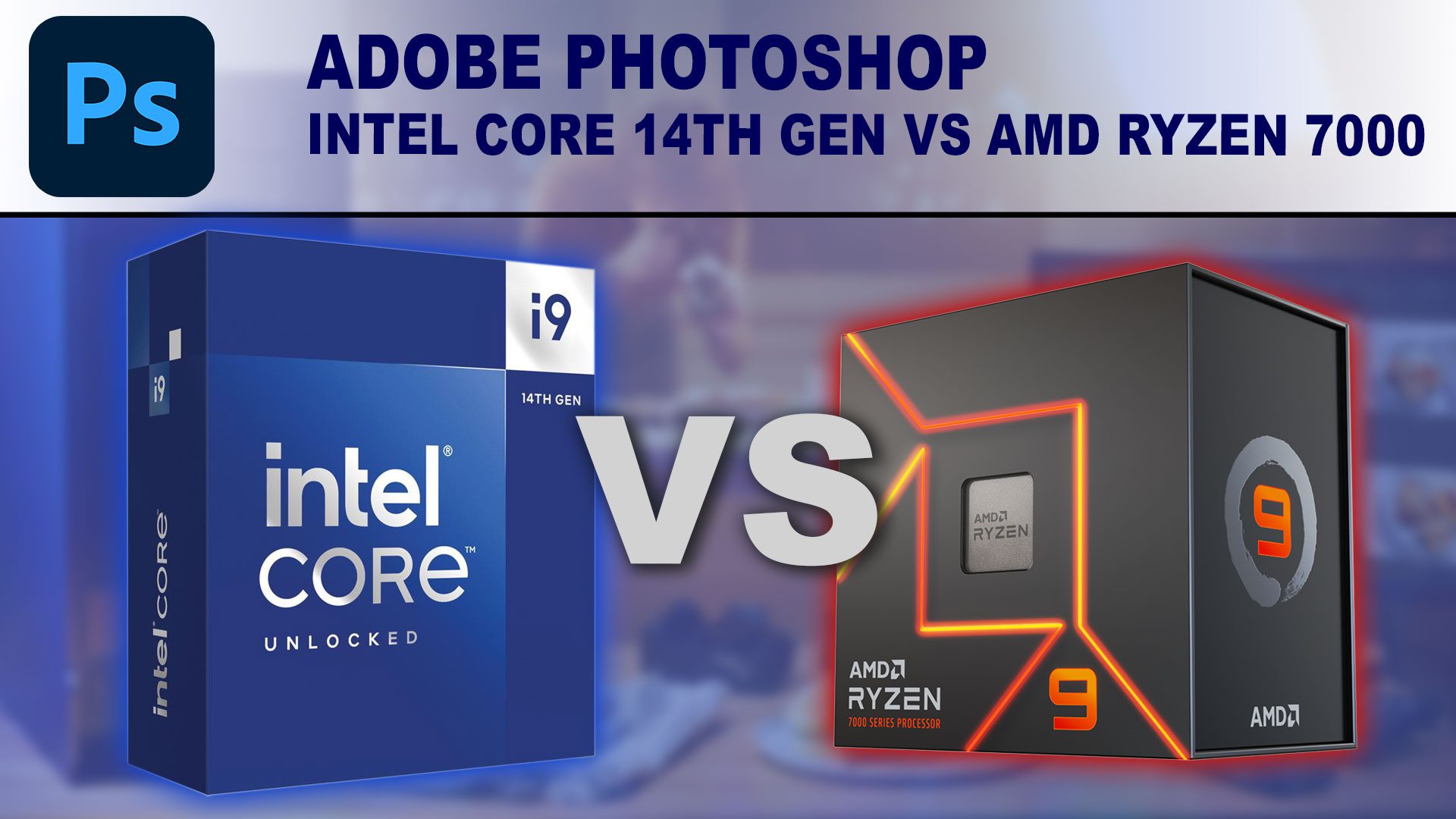
If you want to read more about the new Intel 14th Gen Core CPUs and what separates them from the previous generation, we recommend checking out our main 14th Gen Intel Core Processors Content Creation Review article. That post includes more detailed information on the CPU specifications and an overview of testing results for a range of other applications, including Lightroom Classic, Premiere Pro, DaVinci Resolve, After Effects, Unreal Engine, Cinema 4D, Blender, and V-Ray. Although these CPUs, like the previous generation, can draw a large amount of power, we are currently disabling any features that run the tested CPUs outside of manufacturer specifications. We are also running the CPUs at the “standard” power profiles, as this is how we currently ship out systems. For more information about the impact of the power profile and how larger coolers affect the performance of the CPUs, you can refer to our Power Draw and Cooling: 14th Gen Intel Core Processors article.
Raw Benchmark Data
Although our benchmark scores represent a balanced workload within their respective applications, we like to include individual results that you can examine. If there is a specific task or area where you do most of your work or that represents the largest time-sink, focusing on those results will let you know in a much more detailed way how these components could influence your work.
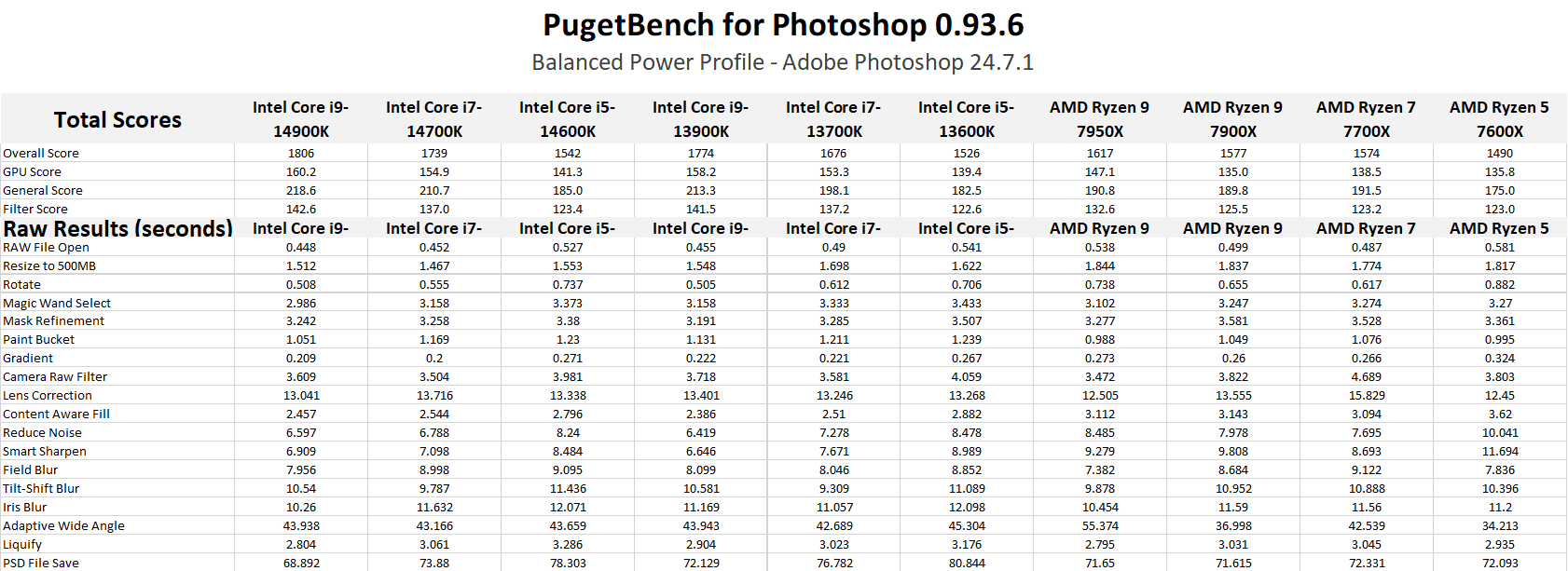
Intel Core 14th Gen vs AMD Ryzen 7000 for Adobe Photoshop
Before getting into our results, we want to note that we tested with Photoshop 24.7.1. Adobe launched version 25.0 when we were wrapping up our testing, and there was unfortunately not enough time to re-test everything (including not only Photoshop, but Lightroom Classic, After Effects, and Premiere Pro as well) before the 14th Gen review embargo. However, we have done some spot-checking, and performance does not appear to be significantly different in the new version for the tasks our benchmark currently looks at.
As we mentioned in the introduction section, Intel has historically held a performance lead over AMD in lightly threaded applications like Photoshop, and this holds true for the new 14th Gen processors as well. Both the Core i9-14900K and i7-14700K are just over 10% faster than the AMD Ryzen 7950X and 7900X, respectively. The lower-end Core i5-14600K is more of a wash, as it is slightly slower than the more expensive Ryzen 7700X, and slightly faster than the less expensive Ryzen 7600X.
Overall, Intel continues to hold the performance crown in Photoshop, although a 10% lead is small enough that you should examine specific CPU pricing for your region (and any active sales that may be ongoing) before picking between Intel and AMD. But, if the absolute best performance is what you are looking for, the Core i9-14900K is certainly the way to go.
Intel Core 14th Gen vs Intel Core 13th Gen for Adobe Photoshop
Even though the Intel Core 14th Gen CPUs are faster than AMD Ryzen 7000 in Photoshop, the truth is that this largely isn’t due to any gen-over-gen performance improvements. In an overall sense, we only saw a 1-4% performance improvement over the 13th Gen processors, which is small enough that it is well within the margin of error for this kind of real-world testing.
Since Photoshop is lightly threaded, the extra E-cores on the Core i7-14700K don’t come into play, and the small .2 GHz increase in Turbo Boost frequency for each CPU is only about a 4% increase at max, and in the real world, the actual benefit works out to be even smaller than that.
How well do the Intel Core 14th Gen CPUs perform in Photoshop?
The new Intel Core 14th Gen processors work fine in Photoshop, although they perform within the margin of error compared to the previous 13th Gen processors. Because of this, Intel maintains (but does not extend) their ~10% performance lead over the AMD Ryzen 7000-series processors. This means that the new 14th Gen CPUs are a solid “skip” generation for Photoshop users, and if anything, make 13th Gen more attractive as there may be price drops now that 14th Gen is fully launched.
Bear in mind that the benchmarks presented in this article are for Adobe Photoshop, and that performance can vary dramatically between different applications; each software will utilize the available hardware differently and so be impacted in a unique way by hardware changes. If you use other software packages in your workflow, we recommend checking out out 14th Gen Intel Core Processors Content Creation Review article, which includes results and links to in-depth testing for a range of other applications, including Lightroom Classic, Premiere Pro, DaVinci Resolve, After Effects, Unreal Engine, Cinema 4D, Blender, and V-Ray.
Finding the perfect workstation doesn’t have to be complicated. Explore our solutions page for a curated selection of recommended systems for a multitude of applications and workflows, or visit our custom configuration page if you already know the ideal hardware for your needs. If you need assistance with tailoring a system to a unique workflow or have any other questions, we encourage you to reach out to our dedicated technology consultants.


